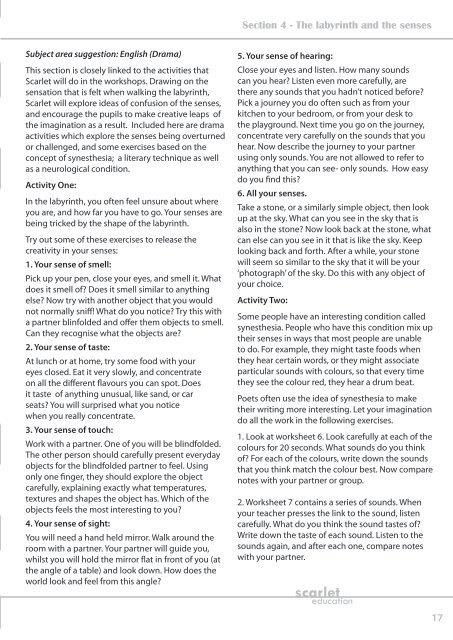labyrinth - Scarlet Theatre
labyrinth - Scarlet Theatre
labyrinth - Scarlet Theatre
Create successful ePaper yourself
Turn your PDF publications into a flip-book with our unique Google optimized e-Paper software.
Section 4 - The <strong>labyrinth</strong> and the senses<br />
Subject area suggestion: English (Drama)<br />
This section is closely linked to the activities that<br />
<strong>Scarlet</strong> will do in the workshops. Drawing on the<br />
sensation that is felt when walking the <strong>labyrinth</strong>,<br />
<strong>Scarlet</strong> will explore ideas of confusion of the senses,<br />
and encourage the pupils to make creative leaps of<br />
the imagination as a result. Included here are drama<br />
activities which explore the senses being overturned<br />
or challenged, and some exercises based on the<br />
concept of synesthesia; a literary technique as well<br />
as a neurological condition.<br />
Activity One:<br />
In the <strong>labyrinth</strong>, you often feel unsure about where<br />
you are, and how far you have to go. Your senses are<br />
being tricked by the shape of the <strong>labyrinth</strong>.<br />
Try out some of these exercises to release the<br />
creativity in your senses:<br />
1. Your sense of smell:<br />
Pick up your pen, close your eyes, and smell it. What<br />
does it smell of? Does it smell similar to anything<br />
else? Now try with another object that you would<br />
not normally sniff! What do you notice? Try this with<br />
a partner blinfolded and offer them objects to smell.<br />
Can they recognise what the objects are?<br />
2. Your sense of taste:<br />
At lunch or at home, try some food with your<br />
eyes closed. Eat it very slowly, and concentrate<br />
on all the different flavours you can spot. Does<br />
it taste of anything unusual, like sand, or car<br />
seats? You will surprised what you notice<br />
when you really concentrate.<br />
3. Your sense of touch:<br />
Work with a partner. One of you will be blindfolded.<br />
The other person should carefully present everyday<br />
objects for the blindfolded partner to feel. Using<br />
only one finger, they should explore the object<br />
carefully, explaining exactly what temperatures,<br />
textures and shapes the object has. Which of the<br />
objects feels the most interesting to you?<br />
4. Your sense of sight:<br />
You will need a hand held mirror. Walk around the<br />
room with a partner. Your partner will guide you,<br />
whilst you will hold the mirror flat in front of you (at<br />
the angle of a table) and look down. How does the<br />
world look and feel from this angle?<br />
5. Your sense of hearing:<br />
Close your eyes and listen. How many sounds<br />
can you hear? Listen even more carefully, are<br />
there any sounds that you hadn’t noticed before?<br />
Pick a journey you do often such as from your<br />
kitchen to your bedroom, or from your desk to<br />
the playground. Next time you go on the journey,<br />
concentrate very carefully on the sounds that you<br />
hear. Now describe the journey to your partner<br />
using only sounds. You are not allowed to refer to<br />
anything that you can see- only sounds. How easy<br />
do you find this?<br />
6. All your senses.<br />
Take a stone, or a similarly simple object, then look<br />
up at the sky. What can you see in the sky that is<br />
also in the stone? Now look back at the stone, what<br />
can else can you see in it that is like the sky. Keep<br />
looking back and forth. After a while, your stone<br />
will seem so similar to the sky that it will be your<br />
‘photograph’ of the sky. Do this with any object of<br />
your choice.<br />
Activity Two:<br />
Some people have an interesting condition called<br />
synesthesia. People who have this condition mix up<br />
their senses in ways that most people are unable<br />
to do. For example, they might taste foods when<br />
they hear certain words, or they might associate<br />
particular sounds with colours, so that every time<br />
they see the colour red, they hear a drum beat.<br />
Poets often use the idea of synesthesia to make<br />
their writing more interesting. Let your imagination<br />
do all the work in the following exercises.<br />
1. Look at worksheet 6. Look carefully at each of the<br />
colours for 20 seconds. What sounds do you think<br />
of? For each of the colours, write down the sounds<br />
that you think match the colour best. Now compare<br />
notes with your partner or group.<br />
2. Worksheet 7 contains a series of sounds. When<br />
your teacher presses the link to the sound, listen<br />
carefully. What do you think the sound tastes of?<br />
Write down the taste of each sound. Listen to the<br />
sounds again, and after each one, compare notes<br />
with your partner.<br />
scarlet<br />
education<br />
17


